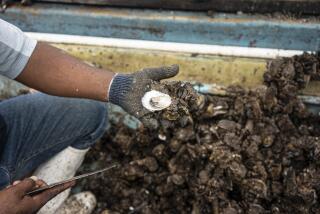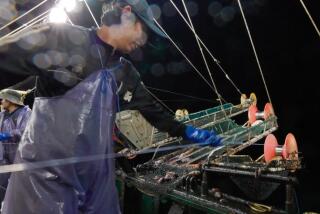Reducing the Risks When Eating Fish
- Share via
What’s a seafood lover to do these days? While the politicians and pressure groups continue to debate turf battles over mandatory seafood inspection, the guy on the street is stuck wondering whether his favorite fish dish is safe to eat.
Nobody, not even the diehards who are screaming for safer seafood, advises eliminating this healthful food from a diet. But everyone from the U.S. Food and Drug Administration to consumer advocacy groups agree that you can reduce the risk of illness or death. The following advice is compiled from Public Voice for Food and Health Policy, the Center for Science in the Public Interest and FDA.
--Eat a variety of different kinds of fish and shellfish. Do not concentrate on only a few species.
--Select young or small fish because they have had less time to accumulate contaminants in their flesh.
--Trim away the skin and any dark flesh before cooking. The highest chemical contaminants concentrate in these areas.
--Don’t eat the mustard in blue crabs or the tomalley in lobsters; PCBs and cadmium concentrate in these areas.
--Shellfish taken from contaminated waters can causes viruses, the bulk of seafood-associated diseases. Avoid raw shellfish if you have chronic liver or kidney problems, diabetes or any disease that impairs the immune system, such as AIDS or AIDS-related complex.
--Forget the trendy undercooked fish that is popular in many restaurants. Fish should be heated to 140 degrees in the center.
--When cooking clams, mussels and oysters, allow them to sit in hot water for five minutes after the shells have opened.
--If you are pregnant or breast-feeding, avoid bluefish, striped bass, swordfish, shark or any freshwater fish. The bluefish and bass often accumulate high levels of PCBs. Swordfish and shark often contain methyl mercury.
--Limit tuna consumption, fresh and canned, to 8 ounces a week because of methyl mercury contamination.
--Avoid the larger reef fish: grouper, snapper, barracuda and Spanish mackerel are the chief candidates for ciguatoxin. Because the toxin is heat stable, cooking does not make the fish safe to eat.
--Scombroid poisoning can result in certain fish that aren’t stored properly and form histamines. The three fish typically associated with these complaints include tuna, mahi-mahi and bluefish. The heat-stable toxin often gives the fish a peppery taste.
--When buying or ordering fish, make sure to ask where it was caught. If it is caught near shore or industrial pollutants, you may want to reconsider.
More to Read
Eat your way across L.A.
Get our weekly Tasting Notes newsletter for reviews, news and more.
You may occasionally receive promotional content from the Los Angeles Times.










